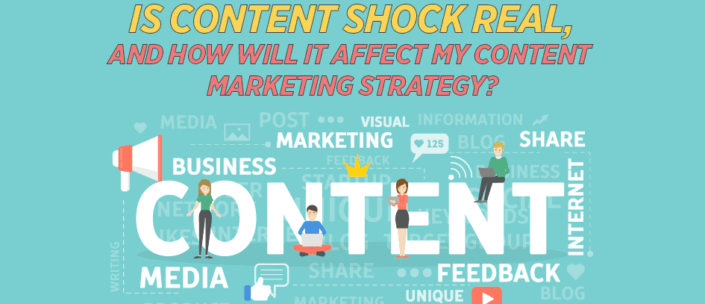Every now and then, we digital marketers hear the term “content shock” whispered around the water cooler, or we read it in an article shared with trepidation among content marketers on Twitter.
If you’re not familiar with the idea of content shock, it basically means that we’ve hit the point of diminishing returns with content marketing. There is so much content being created and shared every day, every hour, that a piece of content that might have been effective 1 year ago may today be hardly a blip on your audience’s radar.
Content shock doesn’t get as much attention as it should because, well – it’s scary. It means change. It means strategizing in new ways. It means looking at our content marketing strategies with fresh, unbiased eyes. That’s a hard thing to make ourselves do.
So let’s get real. How is content shock really affecting your brand and your content marketing strategy? How can you adapt to the times without throwing out the entire content marketing playbook?
Content shock is real, but you’ve probably already adapted – to a certain degree
Here’s the bad news.
Yes, content shock is real. Your well-researched, abundantly backlinked, visually pleasing blog post that you spent 10 hours writing simply will not get the same number of eyes on it today as it would have yesterday unless you pay to promote it. It’s far more likely to be drowned out by the other thousands of similar pieces of content than it used to be.
That hurts, we know, especially since for years, every brand has been hearing how vitally important content marketing is to your overall marketing plan.
Now here’s the good news.
While content shock is, indeed, real, you’ve probably already adapted some of your content marketing practices to deal with this new reality – perhaps without even realizing it.
For example, maybe you’ve expanded into developing video content, in addition to blog posts and whitepapers.
Or maybe you’ve upped your social media ad spend because you’ve noticed your organic reach on Facebook has dropped over the past few years.
There are lots of other strategic decisions marketers are making these days that are a way of dealing with the fallout from content shock. If you’re making any efforts to stay current with digital marketing best practices, then you’re almost certainly engaging in many of these already.
And that means that you don’t have to worry about any sudden effects from content shock – instead, the effects are and will continue to be more gradual.
What exactly are the effects of content shock?
This is how content shock may be affecting your brand and your content marketing efforts:
- Engagement rates are going down, or you’re having to work harder to get the same levels of engagement you had 1, 2, or 3 years ago
- Organic reach rates are plummeting. As marketing expert Mark Schaefer explains in his blog post about content shock, “In 2011, if you did a great job with your content, audience, and engagement, the average brand could expect 26 percent organic reach on content posted on Facebook. Today that number is below 1 percent. Why? There’s simply too much stuff.”
- Your audience doesn’t trust your content anymore. Multiple studies have found that consumers, in general, are becoming more skeptical of branded content due to the overload of marketing messages they receive every day. This is especially true for Generation Z.
These are all serious challenges, but they’re not insurmountable. To combat the effects of content shock, here’s what you need to do.
1. Be more strategic, analytical, and selective about the content you create.
This is by far the most important takeaway when it comes to dealing with content shock.
The answer to getting noticed these days is not, as it used to be, more content. It’s more strategic content – and likely in the next few years, a lot less of it.
As it takes more and more resources to get your posts, videos, whitepapers, and webinars noticed, and in turn, driving conversions, it’s the simple truth that at some point you won’t be able to keep up. You can’t keep paying more and more in social media ad costs, only to get a lower ROI per post.
Instead, the key is to use those resources differently. Instead of having your content team turn out 2 or 3 blog posts per week – even if they’re well-written and highly researched – have them dedicate some time to studying your analytics to see what’s performing well and what’s falling off the map.
Then, based on that research, choose a topic, write a post, and pay attention to the analytics.
You may feel as though you’re slacking, or not doing your job as a content marketer – but consider these facts:
0.5% of the content on the average website drives more than 50% of the traffic.
Some studies suggest that more than 50% and as high as 70% of marketing content created by brands goes completely unused.
Source: Marketing Insider Group
You want to be creating more content like that 0.5%.
0.5% of the content on the average website drives more than 50% of the traffic. Click To Tweet2. Embrace user-generated content (UGC).
In an age in which consumers are ever more skeptical of the content put out by brands, user-generated content can be your best friend.
UGC is simply content that your users create that tags or mentions your brand in some way.
It can be solicited by a brand, or spontaneous and unsolicited. Unsolicited UGC is any content a user posts that mention your brand. Someone tags your brand in a Facebook post, they tweet at you, they post an image with your product on Instagram – all of that is UGC.
Content shock antidote: user-generated content. Click To TweetSolicited UGC comes in many forms. It can be something as structured as a Facebook sweepstake that asks contestants to enter by posting a picture of themselves with your product on your page.
It could also be simply popularizing a hashtag, as Loews Hotels did with their #TravelforReal campaign. The hotel chain wanted to showcase real guests staying in their hotels, so they first searched Instagram for images that users had posted of their properties. They shared the photos with the #TravelforReal hashtag.
Source: Loews Hotels Instagram
Then they began asking followers to post images from their stays at Loews hotels, using that hashtag. It’s since become a highly successful campaign, partly because of its uniqueness, and partly because of its transparency. Users who view the images know they’re real and spontaneous – not posed, doctored PR photos.
3. Accept that Facebook, Instagram, and other social media platforms are generally pay-to-play for the majority of brands.
For many brands that used to rely on Facebook as a largely free method of getting their message out to the world, it can hurt to acknowledge that the platform’s organic reach stats have dropped precipitously.
It used to be enough to post your content on your Facebook page and wait for the click-throughs. Today, there’s simply too much content on the platform for your post to have a fighting chance without at least some promotion.
That doesn’t mean that you have to pour money into promoting Facebook and Instagram posts. One great thing about these platforms that hasn’t changed is that advertising on them can be extremely affordable, while still bringing you a strong ROI.
4. Use social listening to ensure you’re creating content your audience wants.
Social listening means proactively keeping track of what online users are saying about a brand, industry, or topic.
You can do this in a variety of ways. You can use social media management tools like HootSuite, which allow you to set up ongoing searches for your social media handles, branded hashtags, mentions of your brand name, etc. This is both the easiest and most effective way to engage in social listening.
You can conduct regular, manual searches on the social media platforms on which you have a presence.
You can use a tool like Google Alerts, which sends you emails with links to any mentions of specific keywords that you set up. That could be your brand name, relevant topics within your industry, thought leaders, etc.
Once you’ve got your social listening methods set up, it’s time to start looking for trends, recurring themes, and other clues into the kind of content your audience might want.
Is there a particular pain point they keep mentioning? Create a blog post or video addressing that specifically. Is there some element of your product or service that people are confused about? Create a how-to video to clear away the confusion.
Social listening can be extremely helpful when it comes to refining the types of content you want to be putting out into the world.
Content shock doesn’t have to mean throwing out everything you know about content marketing. For more on creating valuable, relevant content that your audience actually wants to read, check out our post “6 Tips for Creating Content That Converts.”







